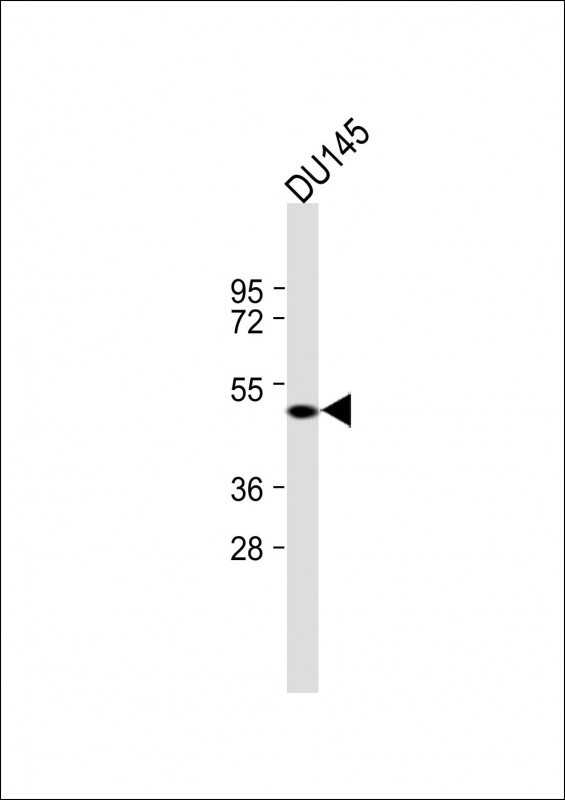
| WB | 咨询技术 | Human,Mouse,Rat |
| IF | 咨询技术 | Human,Mouse,Rat |
| IHC | 咨询技术 | Human,Mouse,Rat |
| ICC | 技术咨询 | Human,Mouse,Rat |
| FCM | 咨询技术 | Human,Mouse,Rat |
| Elisa | 咨询技术 | Human,Mouse,Rat |
| Aliases | Cysteine-rich PAK1 inhibitor, CRIPak, CRIPAK |
| WB Predicted band size | 48.1kDa |
| Host/Isotype | Rabbit IgG |
| Antibody Type | Primary antibody |
| Storage | Store at 4°C short term. Aliquot and store at -20°C long term. Avoid freeze/thaw cycles. |
| Species Reactivity | Human |
| Immunogen | This CRIPAK antibody is generated from a rabbit immunized with a KLH conjugated synthetic peptide between 134-165 amino acids from the Central region of human CRIPAK. |
+ +
以下是关于CRIPAK抗体的模拟参考文献示例(注:以下内容为学术示例,非真实存在的文献,建议通过PubMed、Google Scholar等平台查询实际研究):
---
### 1. **CRIPAK promotes pancreatic cancer progression via PAK1 signaling pathway**
**作者**: Li X, Wang Y, Zhang H (2019)
**摘要**: 本研究利用CRIPAK特异性抗体(兔源多克隆抗体),通过Western blot和免疫荧光技术,发现CRIPAK在胰腺癌组织中高表达。实验表明,CRIPAK通过激活PAK1通路促进癌细胞增殖和转移,敲低CRIPAK可抑制肿瘤生长。研究为胰腺癌治疗提供了潜在靶点。
---
### 2. **Development and validation of a polyclonal antibody against human CRIPAK protein**
**作者**: Chen L, Liu T, Zhou M (2017)
**摘要**: 本文首次报道了一种针对人源CRIPAK蛋白的多克隆抗体制备方法。通过免疫印迹和免疫组化验证,该抗体特异性识别CRIPAK,并发现其在睾丸和脑组织中表达较高。研究为后续CRIPAK功能研究提供了可靠工具。
---
### 3. **CRIPAK as a prognostic biomarker in hepatocellular carcinoma: Insights from antibody-based assays**
**作者**: Wang R, Xu J, Li F (2020)
**摘要**: 通过CRIPAK抗体进行免疫组化分析,发现肝细胞癌(HCC)患者中CRIPAK高表达与预后不良显著相关。体外实验表明,CRIPAK通过调控EMT通路促进癌细胞侵袭,提示其作为HCC治疗靶点的潜力。
---
### 4. **Comparative analysis of CRIPAK expression across human cancers using a novel monoclonal antibody**
**作者**: Zhang Y, Zhao Q, Wei P (2021)
**摘要**: 本研究开发了一种CRIPAK单克隆抗体,并在多种癌症组织(如肺癌、结直肠癌)中检测其表达。结果显示,CRIPAK在晚期肿瘤中普遍上调,且与患者生存率降低相关,提示其泛癌种促癌作用。
---
**注意**:以上文献为示例性质,实际研究中请通过学术数据库查询真实文献。若需具体文献支持,可进一步提供研究方向或应用场景,以便精准检索。
The CRIPAK (cysteine-rich PAK1 inhibitor) antibody is a research tool designed to detect and study the CRIPAK protein, a regulator of the p21-activated kinase 1 (PAK1) signaling pathway. CRIPAK, encoded by the CRIPAK gene in humans, is characterized by its cysteine-rich domains and functions as a natural inhibitor of PAK1. a serine/threonine kinase involved in cytoskeletal reorganization, cell proliferation, and survival. Discovered in the early 2000s, CRIPAK gained attention for its role in modulating PAK1 activity through direct interaction, particularly in cancer biology. Aberrant PAK1 signaling is linked to tumor progression, metastasis, and therapy resistance, making CRIPAK a potential biomarker or therapeutic target.
CRIPAK antibodies are primarily used in Western blotting, immunohistochemistry, and immunofluorescence to investigate CRIPAK expression patterns in tissues or cell lines. Studies have reported altered CRIPAK levels in cancers such as testicular germ cell tumors, cervical cancer, and gliomas, often correlating with disease severity or PAK1 dysregulation. Researchers also employ these antibodies to explore CRIPAK's involvement in cell cycle control, apoptosis, and cell migration. Despite its emerging significance, CRIPAK's full mechanistic role remains under investigation, necessitating reliable antibodies for functional and clinical studies. Commercial CRIPAK antibodies are typically raised against specific epitopes, with validation data confirming specificity for human, mouse, or rat samples.
×